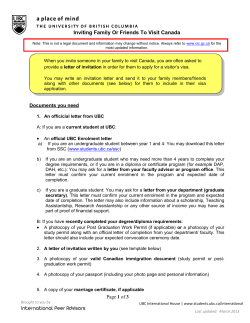
Document 101249
05.06.2013 Agenda NETWORK, CLASS AND LINGUISTIC CHANGE 1. Basic notions of the text 2. Network structures 2.1 Definition and characteristics 2.2 Close-knit communities: Strong ties 2.3 Weak ties Milroy, J. & Milroy L. (1992). Social network and social class: Toward an integrated sociolingustic model. Cambridge: Cambridge University Press. 3. Weak ties, strong ties and linguistic variation 3.1 Belfast Study 3.2 Philadelphia Study 4. Network and class 4.1 Social class and weak ties 4.2 Life-modes SLANG Christian Kretschmer Roland Mühlenbernd Sprachwissenschaft 05.06.13 Matrikelnr. 3619812 4.3 The integrated model of network and class Medienwissenschaft/Allg. 5. Conclusion 1. Basic notions of the text 1. Basic notions of the text Language variation <-> speaker variable • Social Class: Large-scale social, political and economic processes sex class • Social Network: Community and interpersonal age network 1. Basic notions of the text Macrolevel: Social Class 2. Network structures 2.1 Definition and characteristics • What is a network? Linguistic Variation, Linguistic Change Microlevel: Network level of social organization • Boundless web of ties • Anchored to individuals • Relates to persons with whom ego directly and regularly interacts • Between 30 and 50 individuals 1 05.06.2013 2.1 Definition and characteristics 2.2 Close-knit communities: Strong ties • Territorially based • Characteristics of personal networks: • Structural features: shape and pattern of network, e.g. density • Interactional features: content of the ties, e.g. multiplexity, frequency and intensity • Close knit: • Dense (everyone knows everyone else) • Multiplex (individuals know each other in several ways) -> Strong ties 2.2 Close-knit communities: Strong ties 2.2 Close-knit communities: Strong ties • Occurance: • Functions: • Rural areas • Modern cities: • Protect interest of group • Maintain and enforce local conventions and norms that are opposed to the mainstream • Product of cultural diversity • Strong sense of ethnicity and local identity 2.3 Weak ties -> lingustic norms, e.g.vernaculars, are maintained via strong ties whithin close-knit communities 2.3 Weak ties • Casual acquaintances between individuals • Associated with socially and geographically mobile persons • Connection between groups • Lead to weaking of a close-knit network structure -> Channel for innovations and influence between groups http://bokardo.com/images/weak-ties.gif 2 05.06.2013 3. Strong ties, weak ties and lingustic variation 3.1 Belfast Study (Milroy & Milroy) 3.1 Belfast Study (Milroy & Milroy) • Study of vowel variants in 3 inner city communities and 2 higher status communities in Belfast : • Backed /a/ and raised /e/ • Both variants originate from the Ulster-Scots • Backed /a/: Association with men; working class • Raised /e/: Association with women; middle class • Lingustic change: vowel variants have assumed a diametrically opposed social value, although they originate from the same region hinterland , diffuse from east to west of the city 3.1 Belfast Study (Milroy & Milroy) 3.1 Belfast Study (Milroy & Milroy) • Addition of network structure as variable: • „It is the group for whom the vowel has less • /a/: choice of variant <-> network structure for men: /a/ as network marker • /e/: choice of variant <-> network structure for women: /e/ as network marker significance as a network marker that seems to be leading the linguistic change.“ • Close-knit network structure: conservative force • Weak ties: transmitter of innovation • Social process of linguistic change <-> weakening of network links 3.2 Philadelphia Study (Ash & Myhill) 3.2 Philadelphia Study (Ash & Myhill) • Study of “Black English Vernecular” (BEV) • Four groups of speakers: • Core white group • Core black group • Black group that has contact with whites (WBs) • White group that has contact blacks (BWs) 3 05.06.2013 3.2 Philadelphia Study (Ash & Myhill) 3.2 Philadelphia Study (Ash & Myhill) • WBs using white norms: • Capacity of alternation according to occasion of • BWs using black norms: use: in group and out-group functions • Linguistic accomodation and affirmatory effort • Explanation of usage: weak ties • Weak ties to both communities • „The degree to which these speakers use the white norms is increased by the range and number of situations in which they have weak-tie contacts outside their core community.“ • Innovators 4. Network and class 4.1 Social class and weak ties 4.1 Social class and weak ties • Speakers with mainly weak ties: middle-class or • Strong ties: upper-working • Local cohesion and overall fragmentation within society • Middle-class networks: • consist of weak ties • Larger • less kin- and territory-oriented: social and • Weak ties: • Crucial bridges of information and innovation residential mobility • Lower and upper-class: structurally similar! -> Weak ties connect microlevel of network and macrolevel of social class Dense, small, close-knit and kin-oriented 4.1 Social class and weak ties 4.2 Life-modes • Thomas Højrup • Which model of social class is appropriate with respect to the importance of weak ties? • Social class = Large-scale and economically process that splits populations into subgroups • 3 life modes • Conditions associated with these life modes -> different types of network structure 4 05.06.2013 4.2 Life-modes 4.2 Life-modes • Life-mode 1 • Life-mode 2 • Self-employed • Ordinary wage earner • Connection between work and leisure activities: • Familiy and leisure seperate from work activities family involved in production • Strong solidarity ideology -> close-knit network structure of typical workingclass society -> close-knit network structure 4.2 Life-modes 4.3 The integrated model of network and class • Life mode 3 • Higher professional or managerial employee • Monitoring or controlling position • Competitive attitude to colleagues • Family in supportive role to career • Socially and geographically mobile -> weak ties of professional kind, but also strong ties with potential resources 5. Conclusion • Networks: Consensus; Class: Conflict • Strong ties: agreement; Weak ties: change and conflict • Integrated model: • Link between network and class: interrelation • Socioeconomic class (Life modes) –> network structures -> changes and variations of linguistic norms 5
© Copyright 2025





















